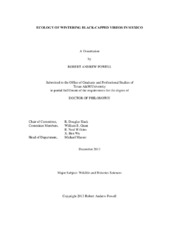| dc.description.abstract | The black-capped vireo (Vireo atricapilla) is an endangered Neotropical migratory songbird that has received considerable attention in its breeding range, but relatively little attention in its winter range in Mexico. To address information needs regarding winter ecology of the black-capped vireo, I conducted research in Mexico focused on investigations of the winter distribution, habitat use, and migratory linkages between breeding and wintering sites.
Over 3 winter periods in 2002–2004, I identified and described the geographic distribution for the black-capped vireo at study sites across 8 states in western Mexico and determined if differential migration occurs among different classes of individuals. I documented winter occupancy in the 5 most northern Mexican states surveyed (Sinaloa, Durango, Nayarit, Jalisco, and Colima), and identified a strong association between sex/age class and winter latitude with adult males occupying habitat at more northern latitudes relative to females and juveniles.
During two winters in 2003-2004, I conducted field research at study sites in Mexico to evaluate patterns of winter habitat use by black-capped vireos and determine which habitat characteristics may influence vireo use of winter patches. Winter habitat use by black-capped vireos was best predicted by increasing values of slope and foliage cover, and by decreasing values of canopy cover and tree diameter. Vireo use plots characterized as thorn forest had greater foliage density, greater shrub density, less canopy cover, and smaller tree diameter than plots classified as tropical deciduous or semi-deciduous forest, suggesting that thorn forests may be most suitable for vireo occupancy during the winter months.
I also used stable carbon, hydrogen, and nitrogen isotopes in black-capped vireo feathers obtained across 3 states in the breeding range and 8 states in the wintering range to determine if vireo feathers collected on the wintering grounds could be used to assess breeding origins and to determine if a relationship exists between breeding and wintering latitudes such as chain or leapfrog migration. Feathers collected at both breeding and wintering sites displayed considerable variability in isotopic composition for all 3 isotopes analyzed, and thus did not provide sufficient information to establish migratory linkages between breeding and wintering sites. | en |


